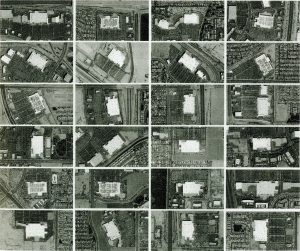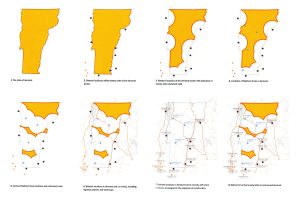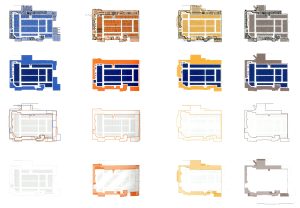Jessie LeCavalier
University of Minnesota Press, 2016

Over the past fifty or so years architects have written a lot about the commercial landscapes of urbanization in North America. These texts responded to an increased influence of commercial or private interests in the production of cities at the beginning of this time period, also referred to as postmodern, late capitalist, or neoliberal urbanization. Some authors are critical of these conditions, while others claim to suspend judgement in order to understand them better. Books such as Learning From Las Vegas or Delirious New York are of the latter type.1 These kinds of texts take lessons from commercial urbanization and extract theories that are used as a basis for making new buildings. More recent texts, such as Jesse LeCavalier’s book, The Rule of Logistics: Walmart and the Architecture of Fulfillment, also try to understand the landscapes of commerce, however with what seem to be a different purpose. One reason to write this book, as the author takes note, is “an interest in the future forms that architecture might take when confronted with systems that exceed its current capacities” (10). Ostensibly, logistics is one example of such a system. This book does not necessarily develop a theory for making an architecture of logistics but instead provides knowledge about how architects and urbanists might more thoughtfully engage in the production of logistically driven landscapes of urbanization today (Figure 1).
The Rule of Logistics is a monograph about the relationship between logistical practices and building production. It tracks the ways that Walmart designs, sites, and occupies buildings from the architectural to the territorial scale. The book begins with an epistemological and theoretical review of logistics, which is followed by an account of how these practices inform a typological design conception of Walmart’s buildings. LeCavalier then reviews how logistics govern decisions about siting of their buildings as a territorial catchment strategy, and finally he focuses on the individuals who manage and operate these buildings as a system of distribution. With this relatively straightforward outline the author threads insights about the discipline of architecture and the nature of contemporary urbanization. In this way, the book uses Walmart and its logistics as a means to qualify and better understand the nature of North America’s highly dispersed and seemingly disordered forms of region building and the relationships that it has to the economies that condition its production.
There are other recent texts have used logistical or infrastructural systems as a way to understand or address the vast scale of North American urban areas. LeCavalier builds on Keller Easterling’s ideas about networked systems as developed in Organization Space (1999). More contemporary examples include Learning From Logistics (2016) by Clare Lyster and Infra Eco Logi Urbanism (2015) by Geoffrey Thun, Kathy Velikov, Colin Ripley, and Dan McTavish; both connect research about systems thinking and regional scales to architectural design proposals at each book’s conclusion. The Rule of Logistics also explores the implications of territorial and infrastructural thinking for design, however it does not include design proposals, and it explores these issues through a historical study of a single commercial entity. In this way LeCavalier’s book, in its tone and approach, is akin to John Harwood’s The Interface: IBM and the Transformation of Corporate Design, 1945–1976 (2011). Through its effort to describe commercially produced forms of urban dispersal, The Rule of Logistics is similar to Alex Wall’s book Victor Gruen: From Urban Shop to New City (2005), an account of Gruen’s designs for retail spaces and shopping malls, and the suburban regions these buildings reshaped.
The Rule of Logistics includes original analytical research about Walmart’s territorial expansion and building enterprises over roughly the last fifty years. One interesting piece of analysis, for example, is LeCavalier’s mapping of Walmart’s developments around Vermont, the last US state that managed to prevent the company from building stores within its border. The maps show stores located at the border of the state and their respective catchment areas that cross that border (Figure 2). My only criticism of the work would be with the positioning of these kinds of narratives. The writing hints of admiration for the ingenuity behind such transgressions, while at the same time acknowledging its dubious political implications. Then again, for some readers such seeming neutrality may be the book’s strength.



LeCavalier extends this kind analysis to the building scale. He includes a series of layered tracings of several Walmart stores, demonstrating that while the store’s format remains consistent in its internal layout, it’s peripheral aspects are somewhat fungible, thus showing how the company’s seemingly rubberstamped buildings adapt to varied sites (Figure 3). Though he does not go on to elaborate a design theory from such observations, he draws connections to methods of architectural design and analysis, in this case typology. This kind of connection provides a means for architects to speculatively engage basic commercial building while still respecting the economies of their production.
Historical research from The Rule of Logistics includes anecdotal stories gathered from interviews and research from the company’s archives. For example, the book starts with a story of a real estate convention in Las Vegas and the various unsuspecting characters mulling about it. It proceeds with an account of Sam Walton, Walmart’s founding CEO, acquiring a pilot’s license to scout prospective building locations from a plane; and then continues to the company’s employees who work the floor of distribution centers using a prosthetic-like “wearable scanners” to more efficiently select inventory (Figure 4). These stories elicit empathy for those who operate and patronize this commercial enterprise, enabling the reader to understand some of the ambitions and desires that drive the production of this ubiquitous commercial network.

LeCavalier concludes the book by reviewing relevant topics in architecture that have been implicated by the practices of logistics—for example, typology, systems based thinking, and territorial scale. It is also at this point that LeCavalier broaches the ethical implications of this kind of research, suggesting how knowledge about logistical practices may be leveraged to pursue alternatives to commercial efficiency and the resultant happiness that acquiring a product may create. “Logistics could instead play a role in the development of a eudaemonistic landscape,” or an alternative space for the city motivated by other moral imperatives (221). While The Rule of Logistics is not really focused on constructing an alternative narrative for commercial urbanization, it suggests that working through the rules of its production is a way to start.
How to Cite this Article: Piper, Michael. Review of The Rule of Logistics: Walmart and the Architecture of Fulfillment, by Jessie LeCavalier. JAE Online. June 28, 2018. http://www.jaeonline.org/articles/reviews-books/rule-logistics-walmart-and-architecture-fulfillment#/.






